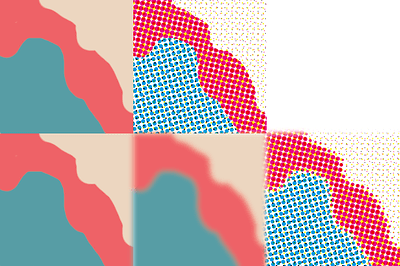Hi. Just some notes (@Grum999, sorry in advance for polluting the thread with stuff related to the halftone filter, but I feel I need to clarify some things):
- The halftone filter uses digital halftoning techniques. Although those techniques try to mimic the traditional analog halftone screen, the results vary. I guess that effect in the borders you like from old comics is because they were printed analogicaly (a real screen and photografic equipment were used to halftone the image). So passing light trought the screen holes would imply some fuzzyness. I mean, the light that passes though the hole comes from an area of the image, not from a single dot. So if that area is half dark and half light (in a border between two shapes for example) the resulting tone ends up being a mid-gray and the dot smaller than inside the shape for example. So for what Grum999 said I think the newspaper pluging mimics something like that, sampling the area.
To achieve the same result using the halftone filter you can just blur the image a bit before applying it. Maybe with a radius half of the screentone cell size. What the blur does is sampling the surrounding area of the current pixel and computing a weighted average that is used to set the pixel. They are 2 steps instead of 1, but I guess in essence that is similar to what the Newspaper plugin does.
- The dots in the screentone generator tend to squares if you use the sinusoidal interpolation. If you use linear they should remain round. The sinusoidal interpolation gives it symmetry: it produces white dots when the brightness is low, black dots when it is high, and kind of a diamond transition shape when it is around 50%.
- One of the best things about the halftone filter is that it is very composable when used as a filter layer/mask, so to achieve a lot of effects they don’t need to be hardcoded in the filter. You just compose the halftone filter with other effects. For example, here it is a layer that has two halftone masks. One produces dots and the other adds noise to the dots borders (with the noise generator):
- I think I’ll have to make an in-depth tutorial.

